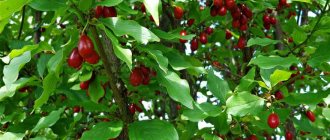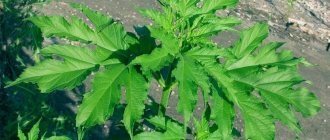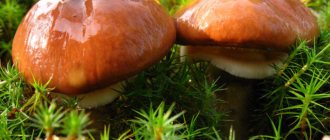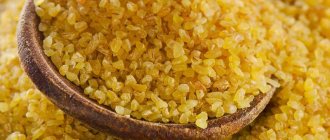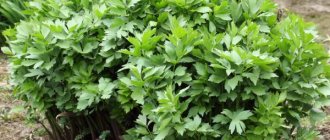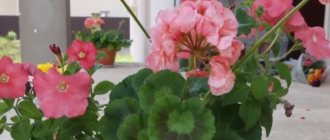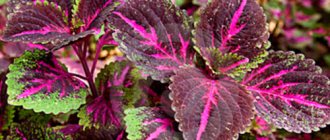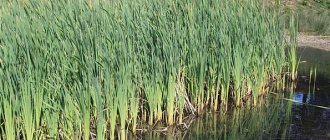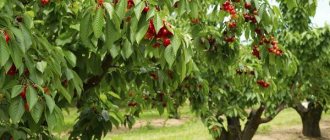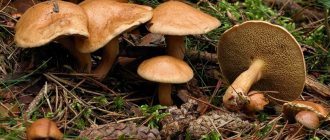Aquatic plants are often used for landscaping artificial ponds. Reed, cattail and reed are used for this, but many do not know the difference between these plants. Not only city dwellers, but also many residents of rural areas do not know how to distinguish reeds from cattails.
Usually people think that there is no difference between cattail and reed, and that they are just the same plant at different periods of development. In fact, they not only differ in appearance, but also belong to different families. In today's article we will look at the difference between these plants and find out what practical use they have found.
Cattail and reed: difference and main differences
Everyone knows the first plant thanks to its velvety brown candles or “horns,” while the second is a less noticeable tall grass (Figure 1).
Figure 1. In the photo on the left - cattails, on the right - thickets of reeds
The difference between cattail and reed is obvious. It is enough to see both plants once, and there will be no more difficulties in distinguishing them.
So, cattail has a tall, large stem with a tight brown ear on top. It contains seeds, and as they ripen, the cob collapses, losing its density. Then the fluffs and seeds fly out of it, leaving a bare stem. The reed stem is triangular or round in cross section; on its crown there are inflorescences in the form of umbrellas, tassels or small heads.
If you look at the pictures of what reeds and cattails look like, the first thing that catches your eye is the difference in the inflorescences, but this is not the only difference:
- Long ribbons, partially submerged in water and stretching from the rhizome itself, belong to cattails - even if they are picked and dried, they will not lose their elasticity for a long time. The width of the leaves directly depends on the species.
- In reed plants, the structure of the leaf also depends on the variety - in lake plants only bare stems are visible, which are covered with scales closer to their roots, while in forest plants they are similar to sedge plants.
- Cattail prefers to grow in bodies of water with slow currents. It is also found in wetlands and stagnant shallow waters.
The external difference between cattail and reed is very significant, but the latter is often confused with swamp reed, which is also completely wrong. A distinctive feature of the reed is a massive soft panicle at the end. The reed inflorescences are hard and prickly, while the cattail inflorescences scatter with seeds and soft fluff, after which they sprout at the bottom of the reservoir.
Application for construction and economic purposes
The scope of application of cattails for technical and utilitarian purposes is even wider. The thickets around the pond are an inexhaustible source of building material.
Dry stems and leaves, tightly tied into sheaves, cover the roofs. The chopped green part is added to clay for building blocks.
Down is used to make filler for life jackets and is used as wall insulation and for caulking wooden log houses and barrels.
Baskets, mats, furniture, and decorative items are woven from the plant. The grass is used for the production of wrapping paper, cardboard, rough fabric, and matting. Dry horn produces a hot flame, so it is used for heating. Potters add fluff to clay to make products made from it light and durable.
The composition of young rush leaves is similar to clover, so the plant is used as livestock feed. It is given fresh, dried, and made into granules to enrich feed.
Expert opinion
Tarasov Dmitry Timofeevich
Master of Sports in mountaineering. Author of scientific articles on the topic of survival in the wild
Recently, artificial ponds that decorate garden plots have become increasingly popular. To decorate them, choose a variety of aquatic grasses: reeds, lilies, cattails, reeds.
The identification of the latter often causes confusion. Some even think that these are two names for one plant.
This is interesting: What to do in case of anaphylactic shock - first aid for an allergy sufferer
To find out the truth, let's find out what distinctive characteristics these plants have.
Description of cattail
It is a tall aquatic grass that forms the only genus of the family of the same name (Figure 2).
Figure 2. This is what cattail looks like
The external features of the aquatic plant are:
- It forms beautiful brown inflorescences at the tops of the stems.
- Its leaves are long and smooth - they grow up to 2 m, and do not have a central vein.
- Generative shoots and rhizomes develop at a depth of 60-90 cm, so it is impossible to see them above water.
- Cattail roots contain a lot of starch and nutrients. Thanks to this, they can be eaten in extreme conditions. They can even be eaten raw, but it is better to cook them or bake them over coals.
- It tolerates frost well and prefers slightly silted ponds, although it can also grow on sandy shores.
- This grass has about 20 species; in our country it is represented mainly by narrow-leaved and broad-leaved types.
There are also decorative subspecies - small and graceful, which are used in landscape design due to their compact size.
If you need to clearly distinguish reeds from cattails, you need to familiarize yourself with the characteristic features of the latter. This is a perennial plant that blooms in June. First, thickenings in the form of scales appear at the ends of the stems, then the flower buds begin to grow and thicken, increase in size, acquiring a bright yellow hue due to the pollen they contain. As the seeds develop and grow, the horn acquires a dark brown color and by autumn becomes soft and velvety, and then shatters into fluff.
Types of perennial
There are from 15 to 30 plant species in the world and almost as many hybrid forms. In the European part of Russia alone, 19 species are found. The most common are:
The wide variety is due to the good adaptability of this grass.
Hybrid species of cattails appeared under the influence of a changing climate and instability of the hydraulic regime. The massive appearance of new hybrids occurs in critical situations: during a sharp cooling or warming, in a reclamation or waterlogging zone.
Expert opinion
Tarasov Dmitry Timofeevich
Master of Sports in mountaineering. Author of scientific articles on the topic of survival in the wild
For a plant that, as a result of evolution, has acquired structurally specialized organs, the emergence of hybrid forms with new properties is the only opportunity to survive in the extreme conditions of modern ecology.
For example, broadleaf cattail has become less common in its natural conditions and more often in areas of transformed or artificial biotope. The species is increasingly acquiring the features of a synanthropic (growing near humans) plant.
Under favorable conditions, it pushes the angustifolia into the deeper water zone, and the intermediate and Laxmana onto the shore and to the shallowest part.
in nature, the plant has many varieties and hybrid forms
Angustifolia cattail, on the contrary, prefers places with deep water and a stable water level. It does not tolerate drying out and cannot recover after the reservoir dries out.
This is interesting: How to make a self-tightening rope loop
This species grows on the banks of shallow reservoirs and in places with a disturbed ecosystem: in wetlands of roadsides, drainage ditches, and settling basins. The plant feels good anywhere, provided that the water depth is more than 50 cm and its level is stable all year round.
Other types of cattail - intermediate, gray and Smirnova - are found at the border of land and water. They can often be seen in wetlands where the grass cover has been disturbed by humans: roadside puddles, overgrown watered and moistened ruts, disturbed floodplains.
Description of reeds
This resident of river banks belongs to the sedge family; among its representatives there are both annuals and perennials (Figure 3).
Based on the description of the species, the features of the reed are as follows:
- There are different types - we have forest, lake and rooting.
- Like reed, it is a cereal and has inconspicuous flowers; it reproduces vegetatively with the help of seeds carried by the wind and its powerful rhizomes.
- Lake and forest subspecies can be found not only near rivers and lakes, but also in flooded meadows and swamps.
Let's figure out how to distinguish reeds from cattails, according to their description. The fruits of the first are small panicles, while those of the second are prickly and have an irregular corymbose shape. Reed stems are bare, with an inflorescence-fruit at the top, and the leaves grow from under the water, almost separately from the stem itself. It does not exceed 2.5 m in height and is easily recognized by the lush green panicles on the tops of the shoots that appear in June.
Figure 3. Appearance of ordinary reeds
The rooting subspecies is remarkable in that, in addition to paniculate inflorescences, it has long stems creeping along the surface of moist soil, which then send roots into it and form a new plant.
Care
Indoor reeds
Can I keep it at home?
For a long time in Rus' there was a sign that swamp reeds should not be kept in the house, as they attract misfortune, illness and death. However, there are other opinions about reeds.
For example, the inhabitants of Ancient Egypt associated this plant with power, because it grew only near bodies of water, which were of great value for an arid country.
And dry reeds placed near the entrance to the home helped scare away ill-wishers.
From a medical point of view, marsh reeds can be dangerous after fading, as they begin to disintegrate into tiny fluff, which can trigger allergic reactions.
In addition, reeds brought from the swamp may bear traces of the vital activity of various animals that are carriers of dangerous diseases.
IMPORTANT! There are decorative reeds that are specially created for growing at home.
Trimming
Ornamental
reed Reed is an unpretentious plant, but it is prone to very rapid growth, and therefore requires regular pruning using pruners to form a beautiful shape. Pruning is best done in late autumn.
Both overgrown roots and wilted leaves are pruned.
Watering
Since reed is a marsh plant, it loves humidity very much. In this regard, it is recommended to water it abundantly.
In the cold season, watering the reeds is slightly reduced, but the top layer of soil in which this representative of the flora grows should not be allowed to dry out. For irrigation, you should use settled soft water.
Once every three days, reed leaves must be irrigated with water.
Feeding
Reeds must be fed with mineral fertilizers, the proportion of which should be one gram per meter. Most often, compost, humus or wood ash are added to the soil.
In moderate quantities, it is allowed to feed the reeds with potassium salt and superphosphate.
In the first months of spring, it is recommended to enrich the soil with urea, and in order for the plant to grow and develop properly, it must be fed every month with fertilizers that do not contain calcium.
Temperature
In summer, the most favorable temperature for reeds is considered to be a temperature not exceeding twenty degrees Celsius, and in winter it is necessary to ensure that it does not fall below eight degrees.
Although it is a cold-resistant plant that can withstand temperatures of five degrees above zero, it still prefers warmth.
Lighting
The reed will feel most comfortable in illuminated areas, but it does not tolerate direct sunlight. The most favorable place for it is considered partial shade.

